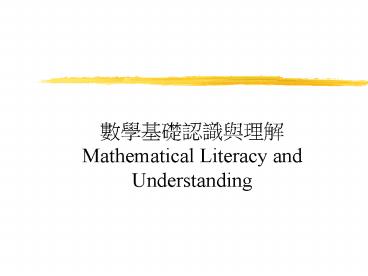Mathematical Literacy and Understanding - PowerPoint PPT Presentation
1 / 28
Title:
Mathematical Literacy and Understanding
Description:
?????????. Mathematical Literacy and Understanding. ????????. ??????????????? ????????? ???????????? ... Same number of marbles? 4/5 years old: Left, yes; Right, no. ... – PowerPoint PPT presentation
Number of Views:24
Avg rating:3.0/5.0
Title: Mathematical Literacy and Understanding
1
?????????Mathematical Literacy and Understanding
2
????????
- ???????????????
- ????????? ????????????
- ??????????????, ??, ??????
- ????????,??? ??????????????
- ????????? ????????????
3
Humans are born with a fundamental sense of
quantity?
Same number of marbles?
4/5 years old Left, yes Right, no. they can
answer correctly until 7-8 years.
4
Younger children do not posses a conceptual
understanding of numbers and that any number
re-related activities are learned by rote?
5
2 1/2 years to 4 1/2 years olds
Take the row you want to eat, and eat all the
MMs in that row.
Children understand more than and less than.
6
Numerical Competencies
- Numerosity (???) ??????
- Ordinality(???) ??????
- Arithmetic ??????
7
????
- ???????????????? ????, ?????????????
- ??????????(Innate)??????????
- ??????????, ??????????????????????
8
Numerosity
- Habituation procedure dishabituation means
notificaiton of number of presented dots changed. - 4 months to 7 1/2 months discriminate 2 from 3
items but not 4 from 6 itms. - 10 - 12 months 2 from 3, not 4 from 5
- infants look longer when 2 dots presented with 2
drum bits, (abstracts codes for numerosities up
to 3 or 4 items)
9
Infants abilities in numerosity
- Not dependent on a specific modality
- not influenced by factors such as
- whether dots or household items are presented,
- whether the presented items are static or moving,
- density of the displays
10
Ordinality
????
- Infants sensitive to numerosity implies they
understand larger than or less than? - Ordinality before or after numerosity? Why?
11
Ordinality
- Infants represent numerosity do not imply they
can rank the representations. - Developed during the first 1 1/2 years of life.
12
????
- ??????????, ????????
- ???????????????, ????????
13
Arithmetic
- Infants have a preliminary sense of addition and
subtraction at 5 months of age.
Objects take out or add in
Infant looks in this direction
14
????
- ?????????????
15
Development of Early Numerical Abilities
- Subitizing
- Counting
- Estimating
16
Reaction Time Patters for Making Numerosity
Judgments
17
????
- ??????????
18
Error Rates
- Rare for arrays with 4 or fewer items
- gt50 for arrays with more than 7 items
19
????
- ????????? ?????????
- ????????
- ?????? ??????? ??????????????
- ???????????, ??????????,???????????
20
Properties of Number System
- Each number word is unique and represent a unique
quantity - numbers are serially ordered
- each number reflects a group of smaller numbers.
21
Counting basic skills involved
- One-to-one correspondence between number names
and the counted items - order the number names in the correct sequence
- the last number named in the count (the cardinal
number) represents the total number of counted
items.
22
Cardinality and Ordinality
- Cardinality number word assigned to the last
counted object can be used to represent the total
number of the counted objects - Ordinality successive number words represent
successively larger quantities.
23
Cardinality and Last-word Rule
- Test of cardinality
- A child is asked to count his or her fingers
- asked, How many fingers do you have?
- understand the concept of cardinality or just use
the Last-word Rule? - Cardinality is always confused by how the items
are arranged.
24
Ordinality
- Refers mostly to the childs knowledge of
equivalence and greater than and less than. - Children as young as 2 1/2 years of age have an
understanding of ordinal relationships.
25
Developmental Mechanisms for Counting and Number
Knowledge
- Most researchers agree that a sensitivity to
numerical information is, at least in part,
inborn, there is considerable disagreement over
the relative importance of this innate
sensitivity. - Tow general positions
- principals-first innate principles guide the
development, - procedures-first first count by rote and
gradually induce counting concepts.
26
Principles-First
- Behavior of young children guided by 5
principles - one-one correspondence one number word one
counted object - stable order same sequence of number words for
counting - cardinality the number word associated with the
last counted item has a special meaning. - Abstraction awareness of what is countable
(skill at counting mixed sets too) - order irrelevance
27
- The principles guide and structure the childs
counting behavior, serve as a reference against
which the child can evaluate this actual counting
behavior, and motivate that behavior.
28
Procedure First
- Children first learn to count largely by rote
through the imitation of parents or siblings, for
example. - Induces basic principles by noticing regularities
in the outcome of counting.































